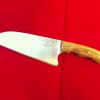Hello all,
I’m new to this forum and I’m looking for a little help from you experts. I’ll give a little background on me. My name is Brendan and I’ve been in the Navy for almost 18 years. I’m currently running the navy sniper course in Indiana and I’ve got just a couple years left until I retire, which I’m really looking forward to.
I got into blacksmithing about a year ago, primarily for the reason of making knives (like so many do) and have been obsessed with it since. I haven’t made that many but I’d like your thoughts from what you see here. I realize I can’t show how it’s heat-treated but I’ll do my best to explain.
The below knife is forged from 1095 (¼ in thick, 1.5 in wide) stock. I hammered it to this desired thickness, annealed in vermiculite, cut the Sudoku shape, cold hammered a bit, normalized twice and on the third heat quenched in peanut oil. Washed off the oil and began to grind. I would have liked to get the grind farther up the blade but I’m a perfectionist and need a straight line. If I reduce the angle too much on my 42 in belt grinder I loose my perfect line and one side will inevitably have a higher mark. (side note: anyone selling a 2x72?)
I only went down to 320 grit on the blade…actually on the handle too. On that handle I used cocobolo and curly maple. After sanding I used a tung oil finish, 3 coats, buffed, before attaching with 5 min epoxy.
I’ve watched months of videos and surfed many custom knife sites learning along the way. I’ve taken If you would, please give me some feed back on every aspect of what you see. Shape, handle…everything. Also what kind of price would this knife command? Any info I’ve omitted please ask I’ll gladly give. I’ve got many more questions but lets start here.
Thank you all.
geez I'm sorry,
Forgot to write my tempering cycle. After a quick clean from the quench, I tempered for 1:45 hours twice at 400F. THEN I began grinding, carful not to heat it up during that process.
BWForge




I’m new to this forum and I’m looking for a little help from you experts. I’ll give a little background on me. My name is Brendan and I’ve been in the Navy for almost 18 years. I’m currently running the navy sniper course in Indiana and I’ve got just a couple years left until I retire, which I’m really looking forward to.
I got into blacksmithing about a year ago, primarily for the reason of making knives (like so many do) and have been obsessed with it since. I haven’t made that many but I’d like your thoughts from what you see here. I realize I can’t show how it’s heat-treated but I’ll do my best to explain.
The below knife is forged from 1095 (¼ in thick, 1.5 in wide) stock. I hammered it to this desired thickness, annealed in vermiculite, cut the Sudoku shape, cold hammered a bit, normalized twice and on the third heat quenched in peanut oil. Washed off the oil and began to grind. I would have liked to get the grind farther up the blade but I’m a perfectionist and need a straight line. If I reduce the angle too much on my 42 in belt grinder I loose my perfect line and one side will inevitably have a higher mark. (side note: anyone selling a 2x72?)
I only went down to 320 grit on the blade…actually on the handle too. On that handle I used cocobolo and curly maple. After sanding I used a tung oil finish, 3 coats, buffed, before attaching with 5 min epoxy.
I’ve watched months of videos and surfed many custom knife sites learning along the way. I’ve taken If you would, please give me some feed back on every aspect of what you see. Shape, handle…everything. Also what kind of price would this knife command? Any info I’ve omitted please ask I’ll gladly give. I’ve got many more questions but lets start here.
Thank you all.
geez I'm sorry,
Forgot to write my tempering cycle. After a quick clean from the quench, I tempered for 1:45 hours twice at 400F. THEN I began grinding, carful not to heat it up during that process.
BWForge






